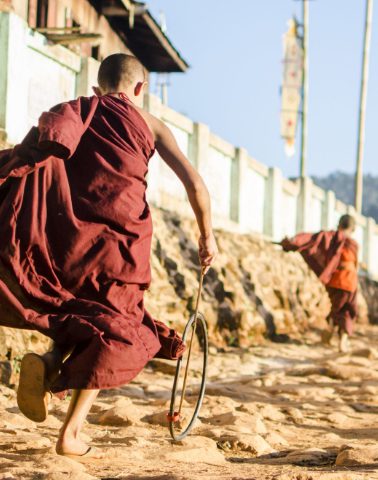
Subscribe to our mailing list
We are still here! Let us send you tips for travelling through Myanmar and stories from the road …
Built upon traditional stilts, Mancotta is slightly outside of the main town and set amongst the tea fields. Sit out on the terrace as the scent of the clipped and fermented leaf infuses the air. Enjoy complimentary tea served in dainty English porcelain alongside shortbread muffins. Travel further afield to the ancient Ahom city of Sivasagar as well as the Raj-era towns of Digboi and Margherita.
FLASH POINT: Take a tea tour through the factory and fields to learn how to create the perfect cuppa.
Mancotta Heritage Chang Bunglow
In what was to them initially a hostile and strange land, the tea planters of the British Raj in India built bungalows. Some of these in Assam were constructed on stilts, so to keep out both the rains and wild animals. These stilts are referred to in Assamese as “chang” or “chang ghars”. Peppered across the tea estates of Assam many “chang bungalows” remain. The last resident of the Mancotta Chang Bungalow was Mr Duncan Hayes of the British Indian Tea company. The present management of the tea estate took ownership in 1970 and in 2001 renovated the bungalow to be rented out to travellers.
There are only six rooms at Mancotta Heritage Chang Bungalow. Each room is named after a tributary of the Brahmaputra. The two master bedrooms on the first floor are Siang and Dihang, each with a double bed. Padma and Yamuna are twins on the ground floor. Lohit and Manas are comfortable single rooms in the annex at the back of the cottage. Each of the rooms has been carefully renovated. There is no flash and no panache. The rooms are simple, tasteful and elegant. And, one imagines, not too dissimilar to how they would have been when Mr Hayes vacated in the `70s.
There are a variety of activities on offer for families staying at Mancotta Heritage Chang. Why not start with the bungalow’s raison d`etre and take a tea tour? The tea gardens are 160 years old. Meet the pluckers and meet the managers – and find out what goes into making the perfect cuppa! Inspect the plants and see the production line. End with a tea tasting. You can also visit Barekuri village and there see the endangered Hollock Gibbon. Alternatively, take a river cruise on the Brahmaputra. Or meet the weavers of Haaj-Paar – creating the muga and paat silks unique to Assam.
One of the most pleasant things about Mancotta Heritage Change is the peace and serenity. It is an ideal location to end after an energetic journey through Assam and the rest of the northeast. Lazy mornings are infused with the smell of tea from the gardens. You may even be able to hear the gentle hum of the factory in the distance. Linger over breakfast on the terrace: leaf through a local newspaper as eggs are prepared as you best like them. Enjoy cups of bright and bold Assamese tea throughout the day. And when the sun begins to set, at dusk take a wander through the neatly pruned tea fields.
There is much beyond Dibrugarh. Travelling southwest, roughly adjacent to the Brahmaputra, travellers can reach the ancient town of Sivasagar. There see the ruins of the Ahom Kingdom – the rulers of which came from eastern Myanmar. East of Dibrugarh there is the town of Digboi (oil museum, bunker and the Commonwealth War Graves). At Margherita see the little shop of curiosities lovingly assembled by the townspeople. And then there is Ledo – site of the start of the Stilwell Road. Just beyond Ledo, is the abandoned cemetery of Jairampur and the Pangsau Pass, in Arunachal Pradesh and on the border with Myanmar. But that, as they say, is another story …
A lovingly restored planter’s bungalow overlooking the hills of Tukdah near to Darjeeling.
Set amongst the pine trees since 1903, with a bold “Green Vision” for the future.
In the heart of Kolkata, this is an escape from the city … and a love-letter to it.